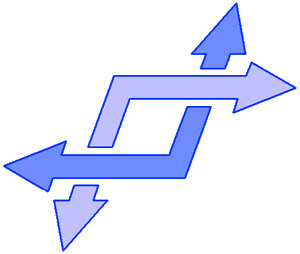


|
|

|
The classical Dragon curve, discovered by physicist John E. Heighway, is the curve that results when a sheet of paper is folded in half, then folded in half again, and again, etc. and is then unfolded in such a way that each crease created by the folding process is opened out into a 90-degree angle. The "curve" refers to the shape of the partially unfolded paper as seen edge on. If one travels along the curve, some of the creases will represent turns to the left and the others turns to the right.
The term "classical" Dragon curve refers to the curve that results when the original folds (as opposed to the more numerous creases that are created) are all in the same direction. For example, a classical Dragon curve consisting of 1024 = 210 segments (10-th order Dragon curve) is created by making ten successive folds all in the same direction. Other distinct Dragon curves can be created by altering the sense of successive folds. For example, a 10-th order non-classical, or generalized, Dragon curve can be created by making ten folds, some of which are left-over-right and the others left-under-right.
N folds result in an N-th order Dragon curve. That is, N folds yield a Dragon curve with 2N segments. Since each of the N folds can be formed in either of two ways, there are also a total of 2N distinct Dragon curves of N-th order.
Remarkably, all Dragon curves of a given type — that is, created by a given sequence of folds — share certain properties. First, none of the Dragon curves intersect, or cross, themselves. Second, and perhaps most remarkable, four copies of the Dragon curve, each starting from the origin in one of the four orthogonal directions (e.g., east, south, west and north), never intersect each other and, in fact, are lattice-space filling (interlocking). That is, every edge of the rectangular lattice along which the segments of the Dragon curves fall is traversed once and only once, with all edges being traversed as the order of the four interlocking curves goes to infinity.
The accompanying drawing, which you can download
(156 Kb, PDF format), shows four interlocking classical 12-th order Dragon curves, each
in a different color. The corners of the curves have been rounded to highlight the fact that
the curves never cross. The drawing file can be viewed or printed using the Adobe Acrobat
Reader, which, if you do not have it, is available free from Adobe
![]() .
.
You can also download (71 Kb) a DOS program called DRAGON that will display in sequence all 2N generalized Dragon curves of N-th order. Curves are drawn interlocked and in different colors. Program DRAGON is highly parametrized for experimentation and can even generate sound in proportion to the instantaneous drawing position on the screen. It is very much recommended that you also download (24 Kb, PDF format) the User's Manual for most effective use of DRAGON.

|
Davis Associates, Inc. • 43 Holden Road •
Newton, MA 02465 U.S.A. • 617-244-1450 • 617-964-4917 (Fax) Unsolicited advertisements not accepted at this Fax number and will be reported to the FCC. |